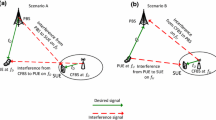Abstract
In this paper, we propose an adaptive non-intrusive cognitive radio network based on smart antenna technologies. The cognitive transmitter (CT), which is equipped with antenna array, first estimates and tracks the composite steering vectors of each primary (licensed) user. In what follows, CT forms transmit beamforming to place nulls to primary receivers based on the estimated spatial signatures. Moreover, we extensively analyze performance degradation caused by spatial signatures mismatch (estimation error) and verify that the proposed robust nulls-steering beamformer can comprehensively alleviate the mismatch effect. Simulation results demonstrate convergence of the proposed gradient-based recursive least squares algorithm. Furthermore, we have shown that outage probability can be kept extremely low under appropriate array size, which ensures the practicability of the proposed scheme.






Similar content being viewed by others
References
Haykin, S. (2005). Cognitive radio: Brain-empowered wireless communications. IEEE Journal on Selected Areas in Communications, 23(2), 201–220.
Cabric, D., Mishra, S. M., & Brodersen, R. W. (2004). Implementation issues in spectrum sensing for cognitive radios. In Proceedings of Asilomar conference on signals, system, computing (Vol. 1, pp. 772–776).
Kolodzy, P., et al. (2001). Next generation communications: Kickoff meeting. In Proceedings of DARPA, October 17, 2001.
Ganesan, G., & Li, Y. (2007). Cooperative spectrum sensing in cognitive radio networks. IEEE Transaction on Wireless Communications, 6, 2204–2222.
Liu, X. & Shankar, S. (2006). Sensing-based opportunistic channel access. In ACM MONET (Vol. 11).
Carbric, D., Mishra, S. M., Willkomm, D., Brodersen, R., & Wolisz, A. (2005). A cognitive radio approach for usage of virtual unlicensed spectrum. In 14th IST mobile and wireless communications summit.
Axell, E., Leus, G., & Larsson, E. G. (2012). Spectrum sensing for cognitive radio: State-of-the-art and recent advances. IEEE Signal Processing Magazine, 7, 101–116.
Letaief, K. B., & Zhang, W. (2009). Cooperative communications for cognitive radio networks. Proceedings of the IEEE, 97(5), 878–893.
Zhang, W., & Letaief, K. B. (2008). Cooperative spectrum sensing with transmit and relay diversity in cognitive radio networks. IEEE Transaction on Wireless Communications, 7, 4761–4766.
Kaur, G., & Bhattacharya, P. P. (2011). Cooperative spectrum sensing and spectrum sharing in cognitive radio: A review. International Journal of Computer Applications in Engineering Sciences, 1(3), 326–330.
Shen, L., Wang, H., & Zhao, W. Z. (2001). Blind spectrum sensing for cognitive radio channels with noise uncertainty. IEEE Transaction on Wireless Communications, 10(6), 1721–172410.
Huang, S., Ding, Z., & Liu, X. (2007). Non-intrusive cognitive radio networks based on smart antenna technology. In GLOBECOM 2007, pp. 4862–4867.
Gharavol, E. A., Liang, Y. C., & Mouthaan, K. (2010). Robust downlink beamforming in multiuser MISO cognitive radio networks with imperfect channel-state information. IEEE Transactions on Vehicular Technology, 9(6), 2852–2860.
Zhi, W. J., Liang, Y. C., & Chia, M. Y. W. (2008). Robust transmit beamforming in cognitive radio networks. In ICCS 2008, pp. 232–236.
Zheng, G., Ma, S., Wong, K. K., & Ng, T. S. (2010). Robust beamforming in cognitive radio. IEEE Transactions on Wireless Communications, 9(2), 570–576.
Haykin, S. (2002). Adaptive filter theory (4th ed.). Englewood Cliffs, NJ: Prentice-Hall, Inc.
Van Trees, H. L. (2002). Optimum array processing. London: Wiley.
Tian, Z., Bell, K. L., & Van Trees, H. L. (2001). A recursive least squares implementation for LCMP beamforming under quadratic constraint. IEEE Transactions on Signal Processing, 49(6), 1138–1145.
Author information
Authors and Affiliations
Corresponding author
Rights and permissions
About this article
Cite this article
Wu, WC. Non-intrusive Cognitive Radio Using Adaptive Nulls-Steering. Wireless Pers Commun 72, 1549–1563 (2013). https://doi.org/10.1007/s11277-013-1095-y
Published:
Issue Date:
DOI: https://doi.org/10.1007/s11277-013-1095-y




